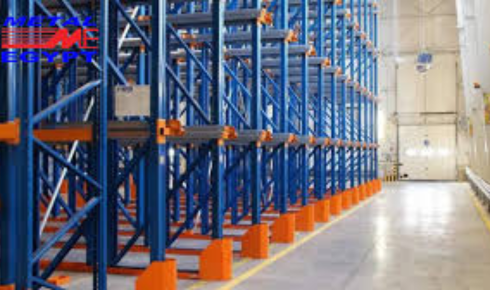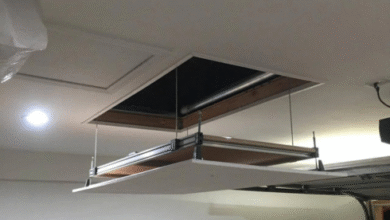Consultancy & Warehouse Design: One Stop Pallet Racking’s End‑to‑End Approach

This article explores the comprehensive approach of One Stop Pallet Racking in providing consultancy services for warehouse design. From initial planning to installation, their end-to-end solutions optimize space, streamline operations, and enhance efficiency. Discover how this consultancy enhances warehouse layouts with tailored pallet racking solutions.
Q Agency delves into innovative strategies for optimizing warehouse operations. Collaborating with experts, they combine state-of-the-art technology and industry knowledge to deliver customized solutions. Their expertise in designing efficient layouts maximizes storage capacity and ensures smooth logistical workflows, making them a leader in warehouse consultancy and pallet racking systems.
Introduction to One Stop Pallet Racking
Introduction to One Stop Pallet Racking
One Stop Pallet Racking is a comprehensive solution for optimizing warehouse storage space and efficiently managing inventory. This system is designed to accommodate palletized goods, offering a versatile and scalable storage solution for businesses of all sizes. The primary objective of One Stop Pallet Racking is to maximize warehouse space utilization while ensuring easy access to stored goods. By utilizing vertical space effectively, this system helps businesses streamline their operations and improve overall efficiency. One Stop Pallet Racking is a cost-effective investment for businesses looking to enhance their storage capacity without the need for significant structural changes or expansions.
Understanding Consultancy Services in Warehouse Design
Consultancy services in warehouse design play a crucial role in ensuring optimal efficiency, functionality, and cost-effectiveness of warehouse operations. These services involve a comprehensive assessment of the client’s current warehouse setup, including layout, workflow, storage systems, and technology integration. Through in-depth analysis and evaluation, consultants identify areas for improvement and develop customized design solutions tailored to the specific needs and goals of the client. This may include optimizing storage space utilization, streamlining material flow, implementing automation technologies, and enhancing safety measures. The expertise and experience of warehouse design consultants enable them to provide valuable insights and recommendations that can significantly enhance the overall productivity and performance of the warehouse facility.
Additionally, consultancy services in warehouse design often involve collaboration with various stakeholders, including warehouse managers, staff, suppliers, and other key personnel. Consultants work closely with the client to understand their unique requirements, constraints, and objectives, ensuring that the proposed design solutions align with the organization’s strategic goals. By fostering open communication and collaboration, consultants can facilitate the smooth implementation of design changes and ensure that the final warehouse design meets the client’s expectations. This collaborative approach not only enhances the effectiveness of the design process but also fosters a sense of ownership and buy-in among all stakeholders, leading to successful outcomes and long-term operational improvements.
Q Agency Seo Agency Sydney (https://www.qagency.com.au/service/seo-agency-sydney) is an example of how specialized services extend beyond typical consultancy, integrating SEO strategies into supply chain operations. By leveraging expertise in digital marketing, they help businesses optimize online visibility, enhancing communication channels with stakeholders, and promoting a seamless flow of information within warehouse management systems.
Importance of End-to-End Approach in Pallet Racking
The importance of an end-to-end approach in pallet racking cannot be overstated in the efficient management of warehouse operations. Adopting this approach ensures that every aspect of pallet racking, from design and installation to maintenance and safety protocols, is carefully considered and integrated into a cohesive system. An end-to-end approach takes into account the specific needs and challenges of a warehouse, such as the type of goods being stored, the frequency of inventory turnover, and the available space. By considering all these factors holistically, businesses can optimize their storage solution to maximize space utilization, improve workflow efficiency, and enhance overall productivity.
Furthermore, an end-to-end approach in pallet racking helps in ensuring safety and compliance with industry regulations. By thoroughly examining every stage of the pallet racking process, including load capacity calculations, rack inspections, and employee training, businesses can mitigate risks and prevent accidents in the warehouse. This approach also facilitates regular maintenance and monitoring of pallet racking systems, which is crucial for identifying potential issues early on and addressing them before they escalate into safety hazards. Ultimately, an end-to-end approach not only enhances operational efficiency but also contributes to creating a safe and organized working environment for warehouse staff, leading to increased employee satisfaction and reduced downtime due to accidents or equipment failures.
Customization and Tailored Solutions for Warehouses
Customization and tailored solutions for warehouses have become increasingly essential in optimizing warehouse operations and maximizing efficiency. Customization allows businesses to design warehouse layouts that cater specifically to their unique needs and requirements. This includes maximizing space utilization, improving workflow efficiency, and ensuring seamless material handling processes. Tailored solutions take into account factors such as the type of products being stored, the frequency of inventory turnover, and specific industry regulations to create a warehouse environment that is optimized for success.
Moreover, customization and tailored solutions for warehouses can also address specific challenges that businesses may face, such as fluctuating demand, seasonal variations, or the need for specialized storage requirements. By customizing warehouse solutions, businesses can adapt to changing market conditions and stay agile in their operations. This flexibility allows for better scalability, cost-effectiveness, and overall operational performance. Ultimately, customization and tailored solutions for warehouses enable businesses to create a competitive advantage by aligning their warehouse operations with their strategic goals and objectives.
Maximizing Space Utilization with Pallet Racking
Maximizing space utilization with pallet racking is crucial for warehouses and distribution centers looking to optimize their storage capacity and efficiency. Pallet racking systems are designed to store materials on pallets in a vertical manner, making use of the vertical space available in a facility. By utilizing pallet racking, businesses can significantly increase their storage capacity compared to traditional shelving systems. The ability to stack pallets vertically allows for more efficient use of floor space, which is especially valuable in facilities where space is limited or expensive.
One key benefit of pallet racking is its adaptability to different warehouse layouts and storage needs. Pallet racking systems come in various configurations, such as selective racking, drive-in racking, and push-back racking, allowing businesses to choose the system that best suits their inventory and workflow requirements. Additionally, pallet racking systems can be customized with accessories like wire decking, dividers, and beam supports to further optimize space utilization and organization. By maximizing space utilization with pallet racking, businesses can streamline their operations, reduce clutter, and improve inventory management, ultimately leading to increased productivity and cost savings.
Efficiency and Productivity in Warehouse Operations
Efficiency and productivity are crucial aspects of warehouse operations that directly impact the overall success and profitability of a business. Efficient warehouse operations involve streamlining processes, optimizing resources, and minimizing waste to ensure that tasks are completed in a timely and cost-effective manner. This can be achieved through various strategies such as implementing warehouse management systems, utilizing automation technologies, and optimizing layout and workflow designs. By maximizing efficiency, warehouses can improve order fulfillment speed, reduce operational costs, and enhance customer satisfaction through faster and more accurate deliveries.
Productivity in warehouse operations is closely linked to efficiency and focuses on the output or results generated from the resources and effort put into the operations. Increasing productivity involves setting clear performance goals, monitoring key performance indicators, and continuously improving processes to achieve higher output levels with the same or fewer resources. This can be accomplished through employee training and engagement, implementing lean principles, and leveraging data analytics to identify areas for improvement. By enhancing productivity, warehouses can increase throughput, handle higher order volumes, and ultimately drive profitability by maximizing the utilization of resources and delivering goods to customers more effectively.
Safety Considerations in Pallet Racking Design
Safety considerations in pallet racking design are paramount to prevent accidents, injuries, and damage to goods stored in warehouses. One crucial aspect is ensuring that the racking system is properly installed and anchored to the floor to withstand the weight of the pallets and prevent collapse. It is essential to follow manufacturer guidelines and local building codes to ensure the racking system is structurally sound. Regular inspections and maintenance checks should be conducted to identify any signs of damage, such as bent beams or loose connections, which could compromise the integrity of the racking system. Additionally, load capacities should be clearly marked and adhered to, preventing overloading that could lead to structural failure.
Another important safety consideration in pallet racking design is ensuring proper aisle width and clearance for forklifts and other machinery to maneuver safely. Aisles should be wide enough to accommodate the specific type of equipment used in the warehouse, with clear markings to delineate pedestrian walkways. Proper lighting and visibility are also crucial factors in preventing accidents, ensuring that workers can see clearly while navigating the aisles and accessing pallets. Implementing safety measures such as guardrails, column protectors, and rack end protectors can help mitigate the risk of collisions and damage to the racking system. Training employees on safe operating procedures and practices, as well as providing personal protective equipment, are essential components of a comprehensive safety plan in pallet racking design.
Technology Integration for Smart Warehousing Solutions
Technology integration plays a crucial role in optimizing smart warehousing solutions by leveraging automation, data analytics, and connectivity. Automated systems such as robotics, AI-driven algorithms, and IoT sensors are seamlessly integrated into warehouse operations to streamline processes and enhance efficiency. These technologies enable real-time tracking of inventory, efficient order fulfillment, and predictive maintenance of equipment, leading to cost savings and improved productivity. Additionally, data analytics tools are integrated to provide valuable insights into inventory management, demand forecasting, and performance monitoring, enabling warehouse managers to make informed decisions for better resource allocation and process optimization.
Furthermore, the integration of connectivity technologies like RFID and barcode scanning enhances visibility and traceability within the warehouse environment. These technologies enable accurate and real-time tracking of inventory movement, reducing errors and minimizing stockouts. Integration of cloud-based platforms and warehouse management systems further enhances operational efficiency by centralizing data management, facilitating collaboration among different warehouse functions, and enabling remote monitoring and control. By integrating these various technologies, smart warehousing solutions can adapt to dynamic market demands, improve customer satisfaction through faster order processing, and achieve a competitive edge in the rapidly evolving logistics industry.
Case Studies: Successful Implementations of One Stop Pallet Racking
One successful implementation of one-stop pallet racking can be seen in a large distribution center that needed to optimize its storage space and increase efficiency in handling inventory. By investing in a comprehensive pallet racking system that included adjustable beams, wire decking, and aisle protectors, the distribution center was able to maximize its vertical storage capacity while ensuring easy access to goods. The system was tailored to accommodate various types of products, from small packages to large pallets, leading to a more organized and streamlined warehouse operation. The implementation of one-stop pallet racking not only improved inventory management but also enhanced safety measures through the installation of durable racking components that reduced the risk of accidents and damage to goods.
In another case study, a manufacturing facility successfully implemented one-stop pallet racking to address its need for a flexible and scalable storage solution. With the installation of pallet racking systems that featured adjustable heights and configurations, the facility was able to adapt to changing inventory requirements and seasonal fluctuations in demand. The versatile nature of the pallet racking system allowed for efficient space utilization, enabling the facility to store a wide range of products in a cost-effective manner. By investing in one-stop pallet racking, the manufacturing facility improved its operational efficiency, reduced material handling costs, and created a safer working environment for its employees.
Future Trends in Warehouse Design and Consultancy Services
Future trends in warehouse design and consultancy services are expected to be heavily influenced by advancements in technology and automation. With the rise of e-commerce and the increasing demand for fast and efficient fulfillment operations, warehouses are likely to become more automated and digitally connected. This could include the use of robotics for picking and packing, as well as the implementation of advanced warehouse management systems that optimize inventory placement and order processing. Consultancy services will need to adapt to these changes by offering expertise in designing and implementing these technologies, as well as providing guidance on how to integrate them seamlessly into existing warehouse operations.
Additionally, sustainability and environmental considerations are becoming increasingly important in warehouse design. Companies are under pressure to reduce their carbon footprint and operate in a more eco-friendly manner. Future trends in warehouse design are likely to focus on incorporating green technologies such as solar panels, energy-efficient lighting, and rainwater harvesting systems. Consultancy services will need to specialize in helping companies achieve their sustainability goals while also optimizing operational efficiency and cost-effectiveness. Overall, the future of warehouse design and consultancy services will be driven by a combination of technological innovation, sustainability, and the need for flexibility and adaptability in a rapidly changing business landscape.



